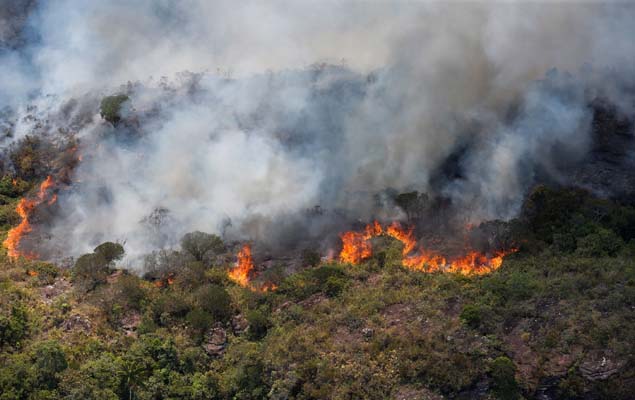Latest Photo Galleries
Brazilian Markets
12h25 Bovespa |
+1,35% | 126.338 |
16h43 Gold |
0,00% | 117 |
12h17 Dollar |
-0,70% | 5,1274 |
16h30 Euro |
+0,49% | 2,65250 |
ADVERTISING
Drought, Lack of Regulation and High Meat Prices Behind Forest Fires in 2015
01/05/2016 - 09h54
Advertising
Venceslau Borlina Filho
FROM CAMPINAS
Drought, lack of regulation and the economic situation increased the number of forest fires in Brazil to 235,629 in 2015, an increase of 27.5% on 2014.
The figures, which come from the National Institute of Space Research (INPE), are close to the all-time record of 249,291 fires, which was registered in 2010.
| Joel Silva/Folhapress | ||
 |
||
| Large and long-lasting forest fires were registered throughout the county, such as in Chapada Diamantina, in Bahia |
According to Alberto Setzer, INPE's fire coordinator, while the drought exacerbated the problem, the root cause is human activity. "There's no such thing as natural combustion," he says. "It is down to human activity, whether through carelessness or on purpose."
The states which suffered most were Pará (44,794 fires), Mato Grosso (32,984) and Maranhão (30,066).
Setzer also identified lack of regulation and the economic situation as aggravating factors, suggesting that the high price of beef increased the number of fires as ranchers burnt down forest in order to open pasture for cattle.
As an example, he cited the increase of 37.9% (to 80,518), the number of fires in the region of Matopiba, a vast area which stretches over the states of Maranhão, Tocantins, Piauí and Bahia, which is important for soya, corn and cotton production.
"We only get annoyed when the fires reach the Amazon," said Setzer. "But they're also spreading through the Cerrado [Savanna], causing environmental damage at the new frontier of Brazilian agriculture."
To be identified by the satellites, the fires need to be at least 30 meters in length by a meter in width.
LONG DURATION
During 2015, large and long-lasting forest fires were registered throughout the county, such as in Chapada Diamantina, in Bahia, from October to December, and in indigenous reserves in Maranhão.
The fires in Chapada Diamantina were finally controlled on December 29, after 64 days, according to the Bahia government. Nearly 51,000 hectares were destroyed - this is the equivalent of Ibirapuera Park, São Paulo's largest, 340 times.
Without enough manpower to combat the blazes, the state and federal governments had to rely on the armed forces. Reinforcements also came in the form of voluntary brigades, formed mainly by local residents.
In the south of Maranhão, half of the Arariboia indigenous reserve was in flames for two months. An area equivalent to 260,000 football fields was destroyed.
Greenpeace environmentalists say that the fires were a criminal attack on the Indians, started deliberately by local loggers. The region is one of the few remaining areas of Amazon Rainforest in Maranhão and is much disputed by different interests.
For Setzer, the number of fires should decrease in 2016, given that there will be less vegetation to burn. "The forests will take a while to recover," he says.
Translated by TOM GATEHOUSE
Read the article in the original language



